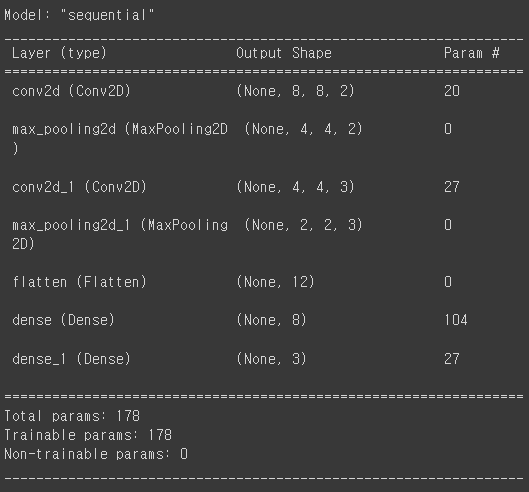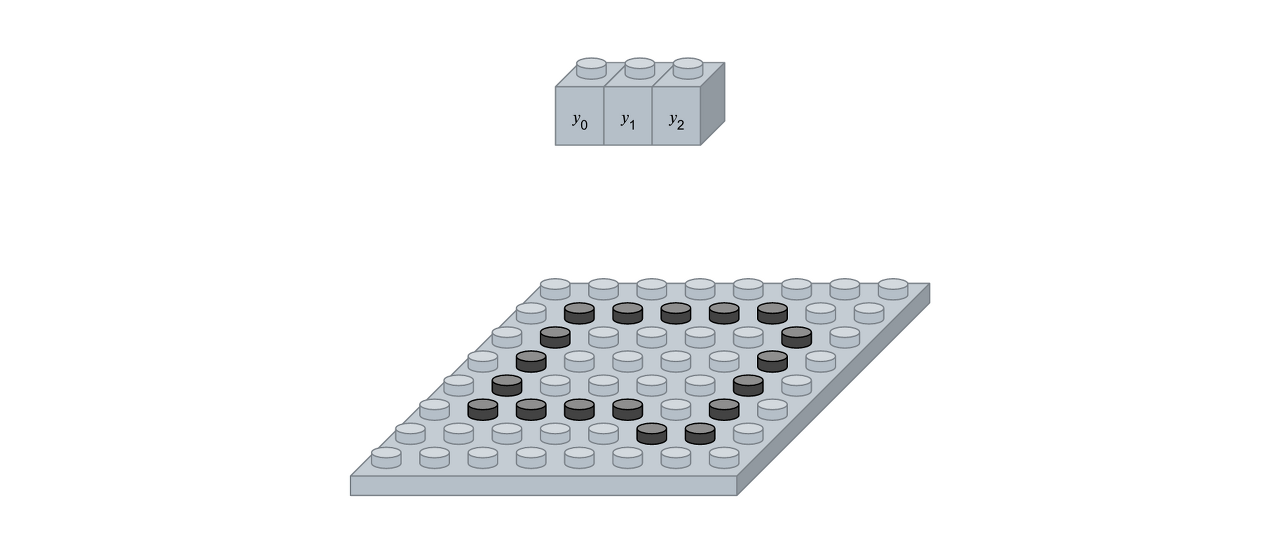삼각형, 사각형, 원을 손으로 그린 이미지가 있고 이미지 크기가 8 x 8이라고 가정
삼각형, 사각형, 원을 구분하는 3개의 클래스를 분류하는 문제이기 때문에 출력 벡터는 3개
# padding = 'same' default
from tensorflow.keras.models import Sequential, Model
from tensorflow.keras.layers import Dense, Conv2D, MaxPooling2D, Flatten
model = Sequential()
model.add(Conv2D(2, (3, 3), padding='same', activation='relu', input_shape=(8, 8, 1)))
model.add(MaxPooling2D(pool_size=(2, 2)))
model.add(Conv2D(3, (2, 2), padding='same', activation='relu'))
model.add(MaxPooling2D(pool_size=(2, 2)))
model.add(Flatten())
model.add(Dense(8, activation='relu'))
model.add(Dense(3, activation='softmax'))
conv2d =
kernel(3,3) * channel(1) * filter(2) + bias(2)
conv2d_1 =
kernel(2,2) * channel(2) * filter(3) + bias(3)
dense =
shape(2*2*3) * node(8) + bias(8)
dense_1=
node(8) * node(3) + bias(3)
1. 가정

2. 컨볼루션 레이어

입력 이미지 크기 8 x 8, 입력 이미지 채널 1개, 필터 크기 3 x 3, 필터 수 2개, 경계 타입 ‘same’, 활성화 함수 ‘relu’
3. 맥스풀링

풀 크기 2 x 2
4. 컨볼루션 레이어

MaxPooling2D로 입력 이미지 크기 4 x 4,
MaxPooling2D로 입력 이미지 채널 2개
필터 크기 2 x 2, 필터 수 3개, 경계 타입 ‘same’, 활성화 함수 ‘relu’
5. 맥스풀링

풀 크기 2 x 2
6. 전결합층

7. Dense layer

입력 뉴런 수 12개, 출력 뉴런 수 8개, 활성화 함수 ‘relu’
8. Dense layer

입력 뉴런 수 8개, 출력 뉴런 수 3개, 활성화 함수 ‘softmax’
9. 결과

https://tykimos.github.io/2017/01/27/CNN_Layer_Talk/
컨볼루션 신경망 레이어 이야기
이번 강좌에서는 컨볼루션 신경망 모델에서 주로 사용되는 컨볼루션(Convolution) 레이어, 맥스풀링(Max Pooling) 레이어, 플래튼(Flatten) 레이어에 대해서 알아보겠습니다. 각 레이어별로 레이어 구성
tykimos.github.io
'Deep Learning, DL > Computer Vision' 카테고리의 다른 글
| 전이학습 (Transfer Learning), 데이터 증강(Augmentation) (0) | 2022.01.08 |
|---|---|
| Generative Adversarial Networks, GAN (0) | 2021.08.29 |
| AutoEncoder, AE (0) | 2021.08.28 |
| Image Segmentation(FCN, U-Net) (0) | 2021.08.28 |
| Convolutional Neural Networks, CNN / window? (0) | 2021.08.28 |




댓글